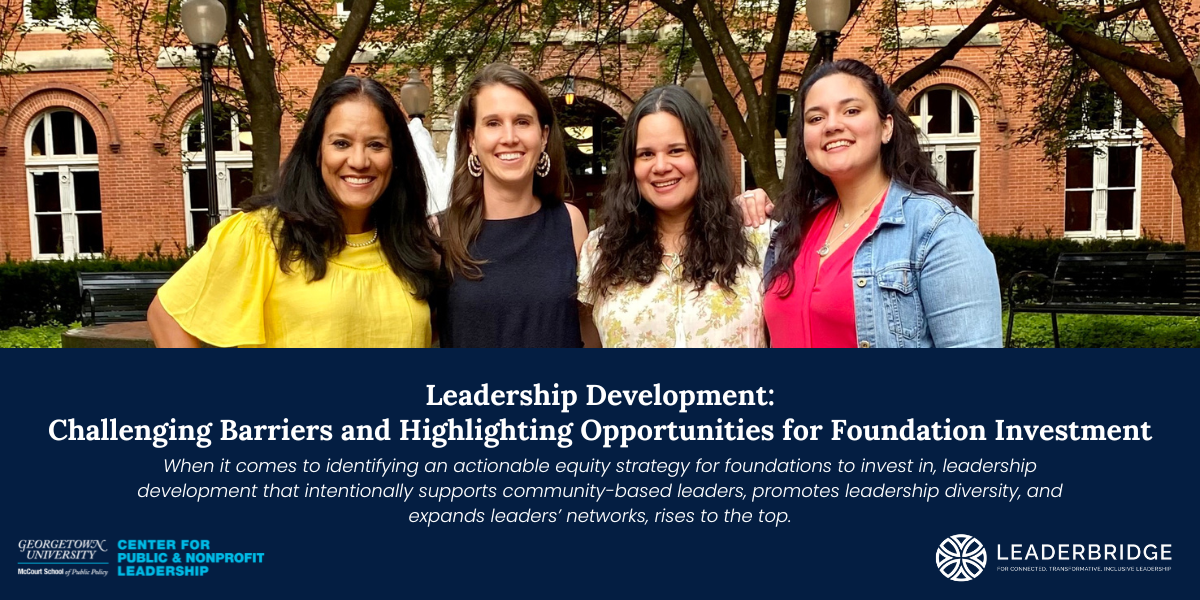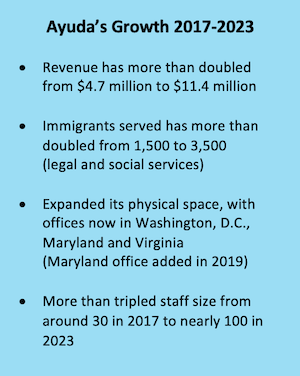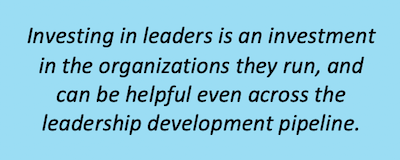Leadership Development: Challenging Barriers and Highlighting Opportunities for Foundation Investment

Posted in News Story
Authors: Luisa Boyarski and Danielle M. Reyes
November 13, 2023 – When it comes to identifying an actionable equity strategy for foundations to invest in, leadership development that intentionally supports community-based leaders, promotes leadership diversity, and expands leaders’ networks, rises to the top.
Since 2016, the Crimsonbridge Foundation has invested in leadership development opportunities through a partnership with the McCourt School of Public Policy’s Center for Public and Nonprofit Leadership (CPNL). Today, LeaderBridge – an initiative of the Crimsonbridge Foundation – has supported the participation of 75 DC area nonprofit leaders of color in CPNL’s Nonprofit Management Executive Certificate Program.
For the Crimsonbridge Foundation, investing in leadership development is a strategic part of its grantmaking approach. “Nonprofit leaders consistently tell us that leadership development is a critical yet underfunded way for their organization to succeed,” says Danielle M. Reyes, President and CEO of the Crimsonbridge Foundation. “There’s a role and opportunity for philanthropy to be responsive.” Together with CPNL, we hear two opposite narratives. One comes from nonprofit leaders who report that in addition to grant dollars leadership development is a huge priority to help themselves and their staff build skill sets, improve overall team retention, and curtail professional burnout.
A contrasting narrative comes from foundations who have held back from investing in leadership development due to perceived concerns that: 1) a leader might leave before the benefit to the organization has been realized, 2) it conflicts with the foundation’s policies against awarding scholarships or funding individuals directly, and 3) the best way to support capacity building is with grant investments that serve the organization, not an individual.
Reyes, a 20-year veteran of DC’s foundation community, promotes her support of leadership: “It is one of the best organizational development strategies available today, and yet is among the most underutilized investments when responding to change, challenges, and growth of grantee community partners.”
Together we want to encourage increased philanthropic investment, by sharing insights and creative approaches to support leadership development that address these three common barriers to investment:
Barrier 1: “Leaders could leave the grantee organization or the nonprofit sector and take the knowledge with them.”
From our collective experience, we have not found this to be the case. Since 2016, 88% of professionals participating in the Nonprofit Management Executive Certificate Program with Crimsonbridge Foundation support continue to work in the nonprofit sector. 41% of these participants were promoted at their organization or became executive directors. Investing in leadership development has made it increasingly possible for organizations to promote from within, reducing transition time and money spent on executive recruitment.
Of those who left the nonprofit sector, many continued serving as key liaisons, resources, and partners to nonprofit peers even when working in an adjacent sector. Of those remaining in the nonprofit sector, some moved to other organizations, which is often necessary to advance professionally. Ultimately through leadership development we are sustaining a leadership pipeline to serve the sector.
Barrier 2: “Our foundation does not fund scholarships or individuals directly.”
Leadership development does not have to come in the form of scholarships. One approach could be increasing a program or general operating grant for leadership development. By automatically including leadership development support, grantees will not have to jump through additional hoops to access it.
Another option is to fund program providers who specialize in leadership development. CPNL partners with a few foundations to provide annual Nonprofit Management Executive Certificate Program scholarships. For example, a grant from the Crimsonbridge Foundation specifically supports leaders of color working at community-based nonprofits in the DC metro region. Partnering with program providers helps to ensure sustainable, high-quality executive education for nonprofit leaders. Together as partners, we share lessons learned, adjust recruitment and program curriculum, and provide alums network-building opportunities as a team, rather than on our own.
Finally, a foundation could also partner with a peer foundation already investing in this work, start a funders’ collaborative, or provide funding through a community or operating foundation. No matter which approach a foundation uses, it is important to make sure that the funding is easily accessible to nonprofit leaders.
Barrier 3: “We want to invest in the organization. Funding leadership development seems to benefit the individual more than the organization.”
The Nonprofit Management Executive Certificate Program helps develop leadership and management skills for individuals to build the capacity of their organizations. Each program participant is required to complete a Capstone Management Project which benefits the organization itself, as well as ensures a transfer of knowledge to the organization. Past projects have included: board development, strategic planning, program expansion, and onboarding processes for new employees, to name a few.

Paula Fitzgerald is a graduate of the Certificate program, receiving one of the first scholarships funded by the Crimsonbridge Foundation in 2016. Her organization, Ayuda, provides legal, social, and language services to help low-income immigrants in the Washington DC, Maryland, and Virginia region. Having already worked at the nonprofit for eight years, Paula was promoted to the Interim Executive Director role, and she applied to the Certificate program to prepare herself for possibly assuming the full-time executive director position. “I brought back a lot of lessons learned to Ayuda. We applied budgeting principles that I learned in the following fiscal year’s budget. I also brought back a lot of ideas for strategic planning and setting the organization’s values. The relationships I developed help me support Ayuda by providing some potential partnerships or sources of additional ideas.” Today, Paula is Ayuda’s Executive Director. She has successfully grown the, now, 11-million-dollar organization to support more than 3,500 low-income immigrants annually across three offices in Washington, D.C., Virginia, and Maryland.
Like Paula, many nonprofit leaders have made an organization’s mission their life’s work. Investing in leaders is an investment in the organizations they run, and can be helpful even across the leadership development pipeline. Support of emerging leaders can signal an investment in their ongoing growth and help build a cohort of peers who they can grow alongside during their careers. It can give more established leaders opportunities to renew their energy for the work, fill gaps in knowledge, and provide a network of peers who can help eliminate the loneliness they may feel in more senior roles.
The Value of Philanthropic Partnership
Since 2016, the Crimsonbridge Foundation and Center for Public and Nonprofit Leadership (CPNL) have had a continued partnership for several reasons:

Ongoing demand – Every session, CPNL receives more requests for scholarships than funding available. For many nonprofits, professional development budgets are limited or may not exist. Crimsonbridge staff hear from leaders that they continue to need access to this type of leadership development opportunity. Many scholarship recipients note that they would not have been able to participate without it.
Importance of providing high-quality educational experiences – Nonprofit leaders deserve access to the highest quality leadership development programming, especially those with proven track records and official credentials that they can put on their resumes. Long-term funding partnerships can ensure that programs like the Nonprofit Management Executive Certificate Program continue to meet the demand of nonprofit leaders of color working in community-based organizations.
Ability to catalyze change – When the Crimsonbridge Foundation first invested in the Nonprofit Management Executive Certificate Program, fewer than 35% of participants reported being a leader of color. Seven years later, the program is more intentional about welcoming leaders of color to participate. During 2023, both program cohorts were 70% comprised of leaders of color. CPNL revised the curriculum, recruited new faculty, and deployed new techniques for marketing to and identifying leaders.
Need for long-term investments to build trust and support – We recognize that leadership development is an ongoing process, which is why Crimsonbridge also invests in alums’ network-building and ongoing leadership development opportunities. 35% of Nonprofit Management Executive Certificate graduates have taken advantage of additional leadership development opportunities. This suggests an ongoing commitment to growing as leaders of their organizations and the nonprofit sector.
Current disparities in foundation support have community-based nonprofit leaders of color receiving fewer and smaller grants than their white counterparts. Leadership development presents a high-impact opportunity for philanthropy to address disparities, drive equity, and build the leadership and organizations needed for a thriving nonprofit sector.
